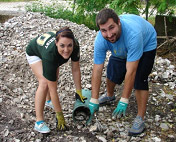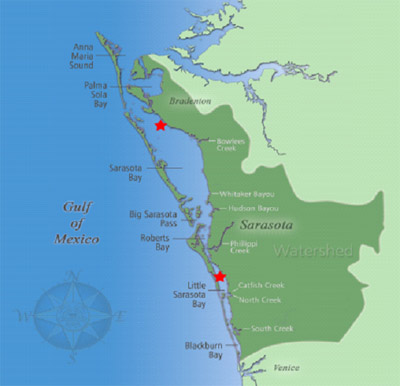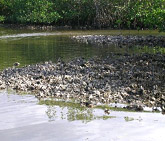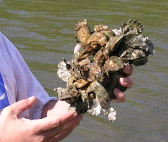How the National Estuary Programs Address — Declines in Fish and Wildlife Populations
The many stresses on estuaries have corresponding impacts on fish and wildlife. As their habitats disappear, the food they depend upon decreases and water quality degrades. Invasive species provide added pressures, replacing many of our native plants and animals.
NEP Approach/Success Stories
Sarasota Bay Estuary Program (SBEP)
In Sarasota Bay, historical maps and charts reveal that many once-vibrant oyster communities have disappeared. The SBEP selected for an oyster habitat enhancement project two sites that were physically disturbed and whose oyster communities were destroyed by coastal development during the 1960s.
Historical maps and charts of Sarasota Bay (located in Florida) reveal the disappearance of many once-vibrant oyster communities, which coastal development during the 1960s destroyed. To help revitalize oyster communities, the SBEP selected two sites for habitat enhancement.
The habitat enhancement effort builds upon the outcomes of an earlier pilot project, which found prospective locations for building new oyster habitats to be substrate limited. Oysters will not recover without the introduction of suitable and sufficient substrate material.

The SBEP team created a total of 4.5 acres of oyster habitat across the two sites:
- 2.5 acres at White Beach in Sarasota County; and
- 2 acres at the Gladiola Fields in Manatee County.

Both locations offered opportunities to create oyster habitat where none existed. White Beach is in a highly urbanized setting where oyster beds once flourished. Over time, shoreline alterations and residential development destroyed them.
The Gladiola Fields lie adjacent to suburban agricultural fields. The creation and restoration of oyster habitat in these areas should improve local water quality by filtering urban stormwater runoff and nutrient-enriched drainage from agricultural fields.
The restoration techniques employed can be readily transferred to other Florida estuaries with similar oyster habitat structure and non-viable oyster populations.
Oyster habitat design for this project replicated existing oyster habitat in Sarasota Bay. At both sites, the SBEP built five 75-foot diameter reefs utilizing fossil shell for the structural foundation. Each reef perimeter consists of a ring of oyster shell "sausages"— shell kept in biodegradable bags to prevent washout and dispersal.
The reef interiors consist of loose shell that provides multi-dimensional complexity. The fossil shell provides substrate for local oyster seed to attach onto and grow. The SBEP team monitors the reefs for oyster survival, growth and utilization by fish and invertebrates.

Volunteers contribute to every aspect of this project, helping to create the oyster "sausages" or bags of fossil oyster, transporting shell and unloading it onto the reefs and assisting with basic reef monitoring. The following community groups provided over 50 volunteers and dedicated 400 hours toward all phases of this project:
- SBEP Bay Guardians
- Sarasota Bay Parrot Head Club
- University of South Florida Environmental SustainaBULLs
- Friendship Volunteer Center's Retirees in Service to the Environment (RISE) Program
- Reef Innovations
This project is funded in part through a national partnership grant between the National Oceanic Atmospheric Administration Community-Based Restoration Program and The Nature Conservancy.

The oyster habitat restoration project in Sarasota Bay and those in other coastal counties in Florida face several challenges. One significant challenge involves the permit process. To deploy material in Sarasota Bay, permits are required at the following levels:
- Federal: U.S. Army Corps of Engineers
- State: Florida Department of Environmental Protection
- Local: Sarasota County Environmental Permitting
These agencies approved the Sarasota Bay projects; however, an exemption was required, as there is no standardized process for obtaining permits from all levels of government for sub-tidal habitat restoration. To address these permitting issues, partners held several strategy development workshops.

Another challenge is to ensure project sites are adequately marked and signage is properly installed. This is to prevent incidental navigation problems or accidents from boats travelling outside marked channels. The SBEP works with staff from both counties to install and maintain markers.
Site monitoring is a key component of restoration efforts. Moreover, monitoring newly-created oyster reefs is necessary to evaluate the effectiveness of construction methods. Permitting and funding agencies often require such monitoring. For example, NOAA-funded projects must be monitored for two years. Currently, SBEP is monitoring the reefs at both project sites for oyster recruitment, growth and survival.
